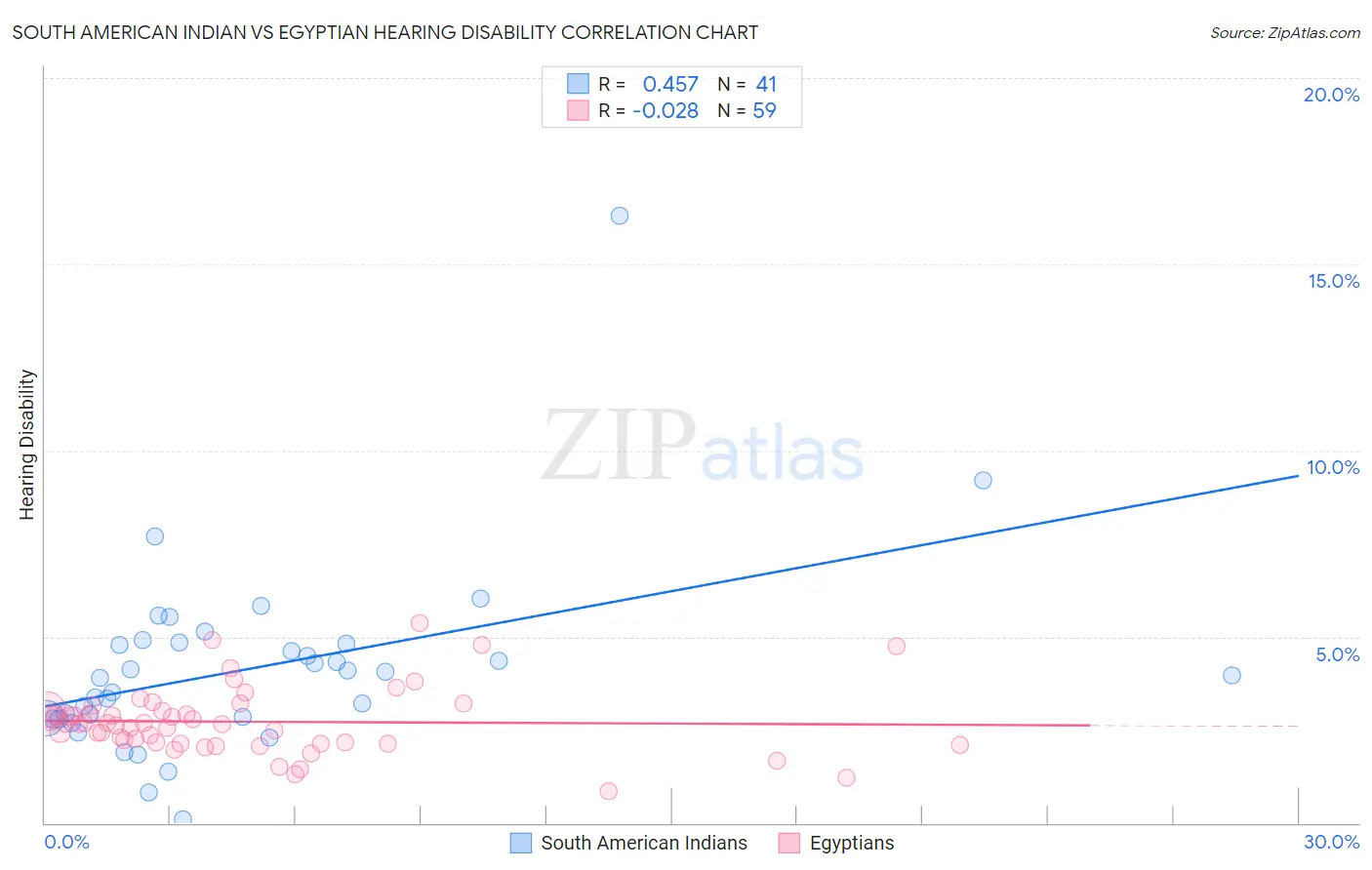South American Indian vs Egyptian Hearing Disability
COMPARE
South American Indian
Egyptian
Hearing Disability
Hearing Disability Comparison
South American Indians
Egyptians
2.9%
HEARING DISABILITY
86.9/ 100
METRIC RATING
127th/ 347
METRIC RANK
2.7%
HEARING DISABILITY
98.1/ 100
METRIC RATING
67th/ 347
METRIC RANK
South American Indian vs Egyptian Hearing Disability Correlation Chart
The statistical analysis conducted on geographies consisting of 164,558,216 people shows a moderate positive correlation between the proportion of South American Indians and percentage of population with hearing disability in the United States with a correlation coefficient (R) of 0.457 and weighted average of 2.9%. Similarly, the statistical analysis conducted on geographies consisting of 276,851,479 people shows no correlation between the proportion of Egyptians and percentage of population with hearing disability in the United States with a correlation coefficient (R) of -0.028 and weighted average of 2.7%, a difference of 5.3%.

Hearing Disability Correlation Summary
| Measurement | South American Indian | Egyptian |
| Minimum | 0.098% | 0.86% |
| Maximum | 16.3% | 5.4% |
| Range | 16.2% | 4.5% |
| Mean | 4.1% | 2.7% |
| Median | 4.0% | 2.7% |
| Interquartile 25% (IQ1) | 2.8% | 2.1% |
| Interquartile 75% (IQ3) | 4.8% | 3.0% |
| Interquartile Range (IQR) | 2.0% | 0.90% |
| Standard Deviation (Sample) | 2.6% | 0.89% |
| Standard Deviation (Population) | 2.6% | 0.88% |
Similar Demographics by Hearing Disability
Demographics Similar to South American Indians by Hearing Disability
In terms of hearing disability, the demographic groups most similar to South American Indians are Immigrants from Western Asia (2.9%, a difference of 0.0%), Immigrants from Uganda (2.9%, a difference of 0.050%), Immigrants from Vietnam (2.9%, a difference of 0.070%), Immigrants from Kenya (2.9%, a difference of 0.16%), and Chilean (2.9%, a difference of 0.21%).
| Demographics | Rating | Rank | Hearing Disability |
| Jordanians | 89.5 /100 | #120 | Excellent 2.8% |
| Cubans | 89.4 /100 | #121 | Excellent 2.8% |
| Liberians | 89.0 /100 | #122 | Excellent 2.8% |
| Immigrants | Zaire | 88.6 /100 | #123 | Excellent 2.9% |
| Bahamians | 88.6 /100 | #124 | Excellent 2.9% |
| Immigrants | Albania | 88.5 /100 | #125 | Excellent 2.9% |
| Immigrants | Sudan | 87.8 /100 | #126 | Excellent 2.9% |
| South American Indians | 86.9 /100 | #127 | Excellent 2.9% |
| Immigrants | Western Asia | 86.9 /100 | #128 | Excellent 2.9% |
| Immigrants | Uganda | 86.6 /100 | #129 | Excellent 2.9% |
| Immigrants | Vietnam | 86.5 /100 | #130 | Excellent 2.9% |
| Immigrants | Kenya | 86.1 /100 | #131 | Excellent 2.9% |
| Chileans | 85.8 /100 | #132 | Excellent 2.9% |
| Immigrants | Syria | 85.8 /100 | #133 | Excellent 2.9% |
| Ugandans | 85.5 /100 | #134 | Excellent 2.9% |
Demographics Similar to Egyptians by Hearing Disability
In terms of hearing disability, the demographic groups most similar to Egyptians are Immigrants from Africa (2.7%, a difference of 0.13%), Nicaraguan (2.7%, a difference of 0.17%), Immigrants from Belize (2.7%, a difference of 0.23%), Immigrants from Nepal (2.7%, a difference of 0.35%), and Peruvian (2.7%, a difference of 0.40%).
| Demographics | Rating | Rank | Hearing Disability |
| Immigrants | Egypt | 98.5 /100 | #60 | Exceptional 2.7% |
| Immigrants | Uzbekistan | 98.4 /100 | #61 | Exceptional 2.7% |
| Immigrants | Colombia | 98.4 /100 | #62 | Exceptional 2.7% |
| Indians (Asian) | 98.4 /100 | #63 | Exceptional 2.7% |
| Immigrants | Sri Lanka | 98.4 /100 | #64 | Exceptional 2.7% |
| Immigrants | Nepal | 98.3 /100 | #65 | Exceptional 2.7% |
| Immigrants | Belize | 98.2 /100 | #66 | Exceptional 2.7% |
| Egyptians | 98.1 /100 | #67 | Exceptional 2.7% |
| Immigrants | Africa | 98.0 /100 | #68 | Exceptional 2.7% |
| Nicaraguans | 97.9 /100 | #69 | Exceptional 2.7% |
| Peruvians | 97.7 /100 | #70 | Exceptional 2.7% |
| Central Americans | 97.7 /100 | #71 | Exceptional 2.7% |
| Afghans | 97.6 /100 | #72 | Exceptional 2.7% |
| Argentineans | 97.5 /100 | #73 | Exceptional 2.7% |
| Immigrants | Korea | 97.5 /100 | #74 | Exceptional 2.7% |